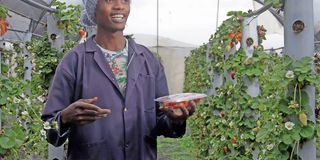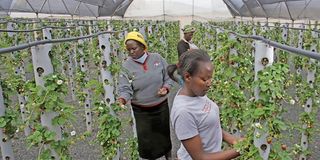For more yields, we grow strawberries without soil

Kelvin Wanjohi the farm manager of the farm named Sangare in Nyeri County explains how they grow strawberries without soil. The farm was started three years ago, but they have been growing the berries for eight months using the technology. PHOTO | JOSEPH KANYI | NATION MEDIA GROUP
What you need to know:
- The farm is located a few kilometres from the Aberdare National Park, which sits on the foot of the Aberdare Ranges, off the Nyeri-Nyahururu highway.
- Inside the structures that sit on half-an-acre of the land, the floor is covered with pumice and water is supplied to the plants using an overhead drip irrigation system.
- The strawberry plants dangle from the pipes; some are flowering, others have unripe berries and a majority are loaded with mature fruit that is ready for picking.
- For top dressing, they use a mixture of CAN and YaraMila Winner fertiliser in a ratio of 1:05kg and finally foliar feeds, which is applied as a supplement on the leaves.
Tens of strawberry plants dangle from the plastic pipes inside a greenhouse, creating a magnificent pattern on the farm named Sangare in Nyeri County.
The farm is located a few kilometres from the Aberdare National Park, which sits on the foot of the Aberdare Ranges, off the Nyeri-Nyahururu highway.
Kelvin Wanjohi, the farm manager, takes the Seeds of Gold team on a guided tour of the five-acre farm.
Besides strawberry, which is the only crop grown indoors, they also farm tomatoes, onions and a variety of vegetables.
The strawberry section, however, is the eye-catching, thanks to the hydroponics technology employed to grow the plants inside four greenhouses measuring 8 by 30m each.
Inside the structures that sit on half-an-acre of the land, the floor is covered with pumice and water is supplied to the plants using an overhead drip irrigation system.
“The pumice stones help keep the farm clean and smother weeds,” Wanjohi says.
The farm was started three years ago, but they have been growing the berries for eight months using the technology.
“We use the vertical hydroponics system where we employ perforated plastic pipes that are two inches in diameter and about two metres tall. They are arranged vertically inside the structure and host cocopeat, on which the plants grow,” offers Wanjohi.
The strawberry plants dangle from the pipes; some are flowering, others have unripe berries and a majority are loaded with mature fruit that is ready for picking.
“This is not our first attempt at strawberry farming. The first time, they did badly due to several challenges,” says Wanjohi of the farm that is owned by Lucy Muthoni, the chief executive of Career Development Ltd.
LOW PRODUCTION COSTS
They had grown the initial crop in an open field and the main undoing was bad weather.
“The wind destroyed the crops. We moved to the greenhouses in October last year but still we had water challenges that made the plants to dry up. We had to replant in January,” he recounts.
The pipes are perforated at a spacing of 15cm from one hole to another before a mixture of cocopeat and pumice is filled inside in a ratio of 1:2. The strawberry splits are then planted inside.

Rahab Wangari, an employee in the farm attends to strawberries that they grow. She says they harvest 400 kilos of the fruit per week. PHOTO | JOSEPH KANYI | NATION MEDIA GROUP
“The pumice is to allow faster flow of water from the top plant to the one at the bottom,” he explains.
Each of the pipes holds at least 42 plants, while the entire farm has over 35,000. They currently grow the Chandler variety in 850 pipes.
The variety is high-yielding, resistant to pests and diseases and has low production costs.
“The crops take 75 days to mature and start bearing fruits. After planting, we apply DAP fertiliser at the top of the pipe for provision of nutrients. The fertiliser is highly soluble as it mixes with irrigation water.”
For top dressing, they use a mixture of CAN and YaraMila Winner fertiliser in a ratio of 1:05kg and finally foliar feeds, which is applied as a supplement on the leaves.
According to Wanjohi, growing strawberries is not labour-intensive and they mature faster, which is an advantage over the other crops.
Rahab Wangari, one of the workers on the farm, explains that the fruits are harvested by breaking the stalk a few inches from the plant, which continues to bear more berries.
“They can be picked for three consecutive years before replacing them. We harvest 400 kilos per week,” says Wangari.
SAVING WATER
The fruits are packed in 250g punnets that sell at Sh100 and Sh400 for a kilo. Before the Covid-19 pandemic, they sold them to tourists at the nearby Sangare ranch, but currently their main markets are supermarkets in Nyeri and Nairobi.
Wanjohi, 23, who studied horticulture at Egerton University, observes that growing the fruits under the hydroponics system saves space and reduces chances of the fruits going bad.
“We have planted the fruits on a half-acre but the production is equivalent to what one can get from two acres in an open field.”

Workers inside a greenhouse in the farm. The crops take 75 days to mature and start bearing fruits. PHOTO | JOSEPH KANYI | NATION MEDIA GROUP
The system further helps in saving water, does not require intensive weeding as is the case in open fields and has reduced infestation of pests and diseases.
“The greenhouses help modify the environment by keeping away pests such as birds. It also reduces evapo-transpiration,” he offers.
He acknowledges, however, that the system of farming requires massive investment of between Sh1.5 million and Sh2 million.
Though not a major problem, Wanjohi noted that one of the diseases they battle is anthracnose, which affects the fruits. Leaf blotch, on the other hand, affects old leaves, thus pruning is crucial.
“We prevent them by spraying fungicides and constantly removing old leaves. For pests, one should watch out for red spider mite, aphids, caterpillars, snail and birds if the crop is grown in an open field,” says Wanjohi, who manages four other workers.
John Wambugu, an agronomist at Wambugu Agricultural Training College in Nyeri, says while the technology is advantageous, high capital needed may put off farmers.
“Other factors to consider when growing the crop is availability of water and the method to irrigate the crops. First do market research to determine the variety to plant and the targeted clientele,” he says.
****
Get it fast
The many nutrients in strawberries
- Strawberries are rich in water, so their total carb content is low — fewer than 8g per 100g.
- Strawberries do not heighten blood sugar levels and are considered safe for people with diabetes.
- The vitamins and minerals in strawberries include:
- Vitamin C, an antioxidant necessary for immunity and skin health.
- Manganese, which is important for many processes in the body.
- Folate, which is one of the B vitamins that are important for normal tissue growth and cell function.


